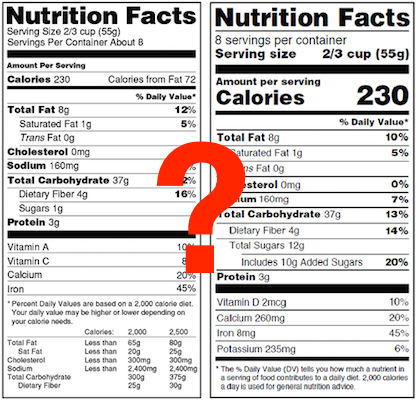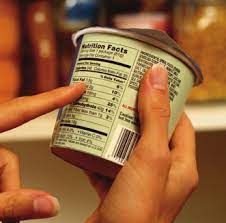Determining FDA Serving Size
One of the places where we often see errors on nutrition facts panels is the suggested serving size. Some food businesses misinterpret the “suggestion” element to mean they can set whatever amount they want. Others simply enter the weight of a serving and don’t understand that it’s meant to convey a common household measure. In this article we’ll break down everything you need to know to make sure you’re accurately labeling your product.
We’ve also built the beta version of serving size finder tool that helps you avoid calculating everything by hand and automatically determines the serving size for your product. It's a widget where you select your product category, enter the weight of a unit/measure, and get the serving size.

If you prefer to learn over video, we have a version on our YouTube Channel and embedded below:
Understanding Suggested Serving Size
The FDA requires the serving size be listed as a common household measure on nutrition fact panels. A common household measure refers to things like 1 bar, 1 cookie, 1 bag, 1 cup, 1 tbsp etc. This type of labeling makes it easier for the average consumer to visualize what a serving size actually is. That said, the suggested serving size is not a health-based recommendation, but rather is meant to represent the amount that is typically consumed by a person in one sitting. To facilitate food businesses properly determining the suggested serving size, the FDA categorized Reference Amount Customarily Consumed (RACC) and the labeling statements that go along with them for a variety of products.
The FDA has three main distinctions for food products that dictate how the serving size should be determined and listed:
- Discrete Units - this refers to products like muffins, sliced bread, or individually packaged products within a multi serving package. For discrete units, the number of units that comes closest to the reference amount is the serving size. For example, the reference amount for cookies is 30 grams and the suggested label statement is __ piece(s). So if one cookie weighs 10 grams, the suggested serving size would be 3 cookies.
- Reference amount / unit weight = serving size
- 30g / 10g = 3 cookies

- Note: The FDA says that the term “piece” is a generic description of a discrete unit, but you should use the description of a unit that is most appropriate for the specific product (so in this case we’d use “cookies” instead of pieces).
- Divided Products - this refers to large discrete units that are typically divided for consumption like cakes, pies, pizzas, and melons. For divided products, the serving size is the fractional slice of the product. For example, the reference amount for pie is 125 grams and the suggested label statement is __ fractional slice. So if a pie weighs 500 grams, the suggested serving size would be ¼ slice.
- Reference amount / unit weight = serving size
- 125g / 500g = .25 = ¼ slice

- Bulk Products - this refers to non-discrete products like breakfast cereal, flour, sugar, and pancake mix. For bulk products, the serving size is the amount in household measure (i.e. cup, tbsp, tsp) that most closely approximates the reference amount. For example, the reference amount for yogurt is 170 grams and the suggested label statement is ___ cups. So if 1 cup of yogurt weighs 340 grams, the suggested serving size would be ½ cup.
- Reference amount / Weight of 1 common measure unit = serving size
- 170g / 340g = ½ cup

These are simple examples because the math works out exactly to basic fractions or whole numbers. However, there are of course a variety of rounding rules for when things don’t work out so neatly.
Serving Size Rounding Rules
Discrete Units
For discrete units, there are rounding rules based on the unit weight to RACC percentage. So the first thing you have to do is figure out the percentage a unit makes up of the reference amount.
Percentage of Reference Amount = (Unit Weight / RACC) * 100
- < = 50% - round to the nearest whole number
- > 50% and <67% - you can declare either one or two units as the serving size
- > = 67% and < 200% - serving size must be declared as one unit
- > = 200% and < =300% - serving size must be proportion of the unit that approximate the reference amount and dual column label is required if servings per container is between 2 and 3.
Divided Products
For divided products, when expressing the fractional slice, manufacturers need to use 1⁄2, 1⁄3, 1⁄4, 1⁄5, 1⁄6, or smaller fractions that can be generated by further division by 2 or 3.
Bulk Products
For bulk products, cups, tablespoons, or teaspoons shall be used wherever possible and appropriate except for beverages. For beverages, a manufacturer may use fluid ounces.
- Cups shall be expressed in 1/4- or 1/3-cup increments.
- Tablespoons shall be expressed as 1, 1 1/3, 1 1/2, 1 2/3, 2, or 3 tablespoons.
- Teaspoons shall be expressed as 1/8, 1/4, 1/2, 3/4, 1, or 2 teaspoons.
Now there’s also the situation where the serving size is a fixed volume amount. For example, the suggested serving size of ice cream is ⅔ cup. In this case, the FDA is giving you the serving size and the only thing you need to figure out is what ⅔ cup of your ice cream actually weighs. It’s important to keep in mind that with something like ice cream (or any volume measure for that matter) the weight will depend on the specific product. For instance some ice creams may contain more air and be lighter, while others may be more dense and heavier at the same exact volume.
What If The FDA Doesn’t Address Your Product Category
Even though it’s the suggested serving size, for the most part, it’s not up to the food manufacturer to determine what that suggestion is. As we’ve seen, the serving size is informed by a clear set of guidelines provided by the FDA. However, there are certainly cases when your product category may not exist or be clearly delineated by the documentation. In these cases, it makes sense to look for categories most analogous to your own product and use your best judgment.
Like many aspects of nutrition labeling, what seems straightforward on the surface, actually has a lot of rules to sort through in order to be compliant. At ReciPal, we’re always working to give you easy-to-use tools that simplify the process. Now, hopefully, figuring out the suggested serving size is one less thing you have to stress about.






